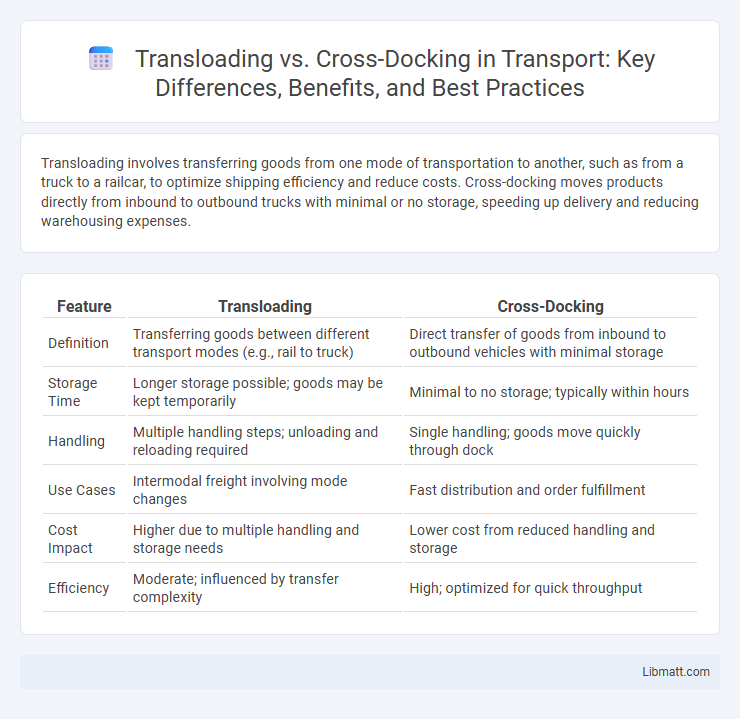Transloading involves transferring goods from one mode of transportation to another, such as from a truck to a railcar, to optimize shipping efficiency and reduce costs. Cross-docking moves products directly from inbound to outbound trucks with minimal or no storage, speeding up delivery and reducing warehousing expenses.
Table of Comparison
| Feature | Transloading | Cross-Docking |
|---|---|---|
| Definition | Transferring goods between different transport modes (e.g., rail to truck) | Direct transfer of goods from inbound to outbound vehicles with minimal storage |
| Storage Time | Longer storage possible; goods may be kept temporarily | Minimal to no storage; typically within hours |
| Handling | Multiple handling steps; unloading and reloading required | Single handling; goods move quickly through dock |
| Use Cases | Intermodal freight involving mode changes | Fast distribution and order fulfillment |
| Cost Impact | Higher due to multiple handling and storage needs | Lower cost from reduced handling and storage |
| Efficiency | Moderate; influenced by transfer complexity | High; optimized for quick throughput |
Introduction to Transloading and Cross-Docking
Transloading involves transferring cargo from one mode of transportation to another, often requiring storage and repackaging, which optimizes supply chain flexibility and reduces handling costs. Cross-docking streamlines distribution by directly transferring goods from inbound to outbound transportation without long-term storage, minimizing inventory holding and accelerating delivery times. Understanding the distinctions between transloading and cross-docking helps your business improve logistics efficiency and meet specific shipping requirements effectively.
Definition of Transloading
Transloading refers to the process of transferring goods from one mode of transportation to another, such as from a ship to a truck or a train, often involving the unloading and reloading of cargo. This method is crucial for optimizing supply chain efficiency, enabling flexibility in shipping routes and accommodating various transportation modes. Unlike cross-docking, which emphasizes quick transfers with minimal storage, transloading may include temporary storage and repackaging to suit different transport requirements.
Definition of Cross-Docking
Cross-docking is a logistics process where incoming shipments are directly transferred from inbound to outbound transportation with minimal or no storage time, enhancing efficiency and reducing handling costs. Unlike transloading, which involves unloading goods from one mode of transport and reloading onto another, cross-docking streamlines supply chain operations by bypassing warehouse storage. This method optimizes inventory flow, shortens delivery times, and is widely used in retail and distribution centers to improve distribution speed.
Key Differences Between Transloading and Cross-Docking
Transloading involves transferring goods from one mode of transportation to another, typically requiring storage and handling, while cross-docking bypasses storage by directly transferring products from inbound to outbound shipments. Transloading is often used for bulk or oversized cargo needing repackaging, whereas cross-docking optimizes fast-moving consumer goods to reduce inventory holding costs. The primary difference lies in the handling time and storage requirements, with transloading offering flexibility and cross-docking emphasizing speed and efficiency in supply chain operations.
Benefits of Transloading
Transloading offers significant benefits including reduced transportation costs by optimizing cargo routes and improving supply chain flexibility through handling multiple shipment modes. It enables efficient inventory management by allowing goods to be consolidated or deconsolidated as needed, enhancing delivery speed and accuracy. You gain better control over logistics operations, minimizing delays and ensuring seamless transfer of goods between transport types for faster order fulfillment.
Advantages of Cross-Docking
Cross-docking minimizes storage costs and reduces handling time by directly transferring goods from inbound to outbound transportation, enhancing supply chain efficiency. Your inventory turnover accelerates, improving cash flow and decreasing the risk of stock obsolescence. This method optimizes warehouse space utilization and boosts order fulfillment speed, leading to increased customer satisfaction.
When to Use Transloading
Transloading is ideal when your shipment requires transferring goods between different transportation modes, such as from rail to truck, to optimize routes and reduce shipping costs. It works best for bulky or oversized cargo that needs specialized handling or repackaging before reaching its final destination. Choose transloading when your supply chain demands flexibility in storage or consolidation, making it more efficient than cross-docking for complex logistics.
When to Choose Cross-Docking
Cross-docking is ideal when your supply chain demands rapid movement of goods with minimal storage time, such as in time-sensitive retail or perishable product industries. This method reduces inventory holding costs and speeds up delivery by directly transferring products from inbound to outbound transportation. Choosing cross-docking enhances efficiency when your operations can align schedules precisely and handle high volumes with consistent product flow.
Industry Applications of Each Method
Transloading is widely used in industries like oil and gas, construction, and agriculture, where bulk materials require transfer from railcars to trucks for local distribution, optimizing long-haul and last-mile logistics. Cross-docking excels in retail, e-commerce, and automotive sectors by enabling rapid sorting and immediate shipment of smaller, pre-packaged goods, reducing storage time and inventory costs. Your supply chain strategy benefits from selecting transloading for heavy, bulk shipments and cross-docking for fast-moving consumer goods to enhance operational efficiency.
Choosing the Right Logistics Strategy
Selecting between transloading and cross-docking depends on shipment volume, storage needs, and delivery timelines. Transloading involves transferring goods between transportation modes, ideal for long-haul shipments requiring consolidation and packaging adjustments. Cross-docking streamlines distribution by moving products directly from inbound to outbound transport, reducing storage time and expediting order fulfillment in high-velocity supply chains.
transloading vs cross-docking Infographic

 libmatt.com
libmatt.com